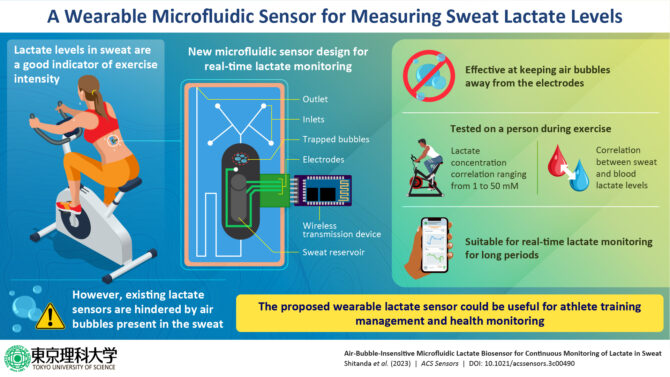
Wearable sensor measures sweat lactate levels during exercise
EP&T Magazine
Electronics Engineering Medical Wearable Technology health medical research sensors Tokyo wearablesScientists solve issue of air bubbles in sweat affecting performance of microfluidic wearable sensors
In a recent study, researchers from Japan have developed a wearable sensor for continuously monitoring sweat lactate during exercise, which incorporates a bubble-trapping region in its microfluidic system. The proposed technology can facilitate athlete training management and health monitoring. Wearable microfluidic sensors can be used to monitor lactate concentration in sweat, a good indicator of exercise intensity. However, air bubbles present in the sweat can get into the microfluidic channels, hindering the measurement.
Human sweat is a rich source of health information, offering insights into a person’s hydration level, electrolyte balance, and overall physiological state. For instance, lactate level in sweat is a useful biomarker of exercise intensity. Its measurement can help estimate the amount of lactic acid in the blood and, in turn, predict muscle fatigue.

Source: Tokyo University of Science (TUS)
Tiny chemical sensors
Today, wearable sensors make it possible to continuously monitor biomarkers such as sweat lactate. Using the latest microfluidics technology, scientists have developed devices that convey minuscule amounts of sweat to tiny chemical sensors, which can transmit their measurements in real time wirelessly. However, one common problem in such devices is that their microfluidic channels tend to trap air bubbles present in the sweat. If these bubbles cover the sensor’s electrodes, the measurements get interrupted, interfering with the continuous monitoring of the target biomarker.
To address this issue, a research team, led by Associate Professor Isao Shitanda from Tokyo University of Science (TUS) in Japan, has come up with a novel microfluidic sweat lactate sensor whose measurements remain unaffected by the air bubbles.
Small wireless transmitter
The proposed wearable device consists of a relatively simple layered structure—a conventional lactate oxidase sensor attached via double-sided tape to a microfluidic system made of a silicone polymer. When the person wearing the device begins to perspire, the sweat enters the microfluidic channels via four inlets and flows toward a reservoir near which the electrodes are located. Old sweat exits the system through an outlet as new sweat enters, and a small wireless transmitter reports the measured lactate levels.
The key innovation in the proposed design was the use of a larger-than-usual sweat reservoir. “By increasing the length of the reservoir in the microfluidic channel, a space of approximately four microliters was created for trapping any air bubbles that infiltrate the device, thereby preventing them from contacting the electrodes of the sensor,” explains Dr. Shitanda.
Soft, flexible and non-irritating material
The researchers tested their sensor in a series of laboratory experiments. They verified that the bubble-trapping region worked as intended by injecting bubbles into the device while measuring lactate levels in artificial sweat. In addition, the measurements were not affected by the sweat flow rate, and the response of the sensor remained stable for approximately two hours. Lastly, the researchers tested the device on a male volunteer who exercised on a stationary bike for almost an hour. The sensor showed a lactate concentration correlation ranging from 1 to 50mM as well as a correlation between sweat and blood lactate levels.
Overall, the results of this study hint at the potential of wearable microfluidic sensors for monitoring sweat biomarkers during exercise. “Since the microfluidic system of the proposed lactate sensor is fabricated from a soft, flexible, and non-irritating material, it could be used to continuously monitor lactate levels in sweat, especially in sports and medicine,” remarks Dr. Shitanda. “Wearable lactate sensors may become useful condition management tools in sports such as soccer and basketball, allowing team managers to know when it’s best to replace a player.”
Only time will tell what training management and healthcare monitoring will look like in the future as wearable sensors become more capable and reliable.
***
Reference
Title of original paper: Air-Bubble-Insensitive Microfluidic Lactate Biosensor for Continuous Monitoring of Lactate in Sweat
Journal: ACS Sensors
https://pubs.acs.org/doi/10.1021/acssensors.3c00490
